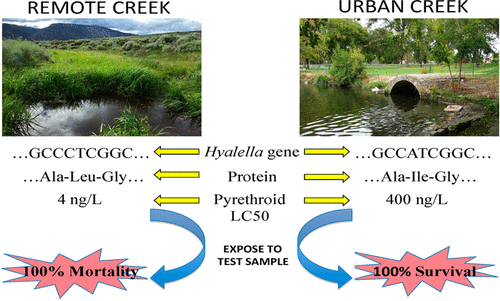当前位置:
X-MOL 学术
›
Environ. Sci. Technol.
›
论文详情
Our official English website, www.x-mol.net, welcomes your feedback! (Note: you will need to create a separate account there.)
Using Mutations for Pesticide Resistance to Identify the Cause of Toxicity in Environmental Samples
Environmental Science & Technology ( IF 11.4 ) Pub Date : 2018-01-04 00:00:00 , DOI: 10.1021/acs.est.7b05071 Donald P. Weston 1 , Helen C. Poynton 2 , Kaley M. Major 2 , Gary A. Wellborn 3 , Michael J. Lydy 4 , Christoph Moschet 5 , Richard E. Connon 6
Environmental Science & Technology ( IF 11.4 ) Pub Date : 2018-01-04 00:00:00 , DOI: 10.1021/acs.est.7b05071 Donald P. Weston 1 , Helen C. Poynton 2 , Kaley M. Major 2 , Gary A. Wellborn 3 , Michael J. Lydy 4 , Christoph Moschet 5 , Richard E. Connon 6
Affiliation

|
Traditional Toxicity Identification Evaluations (TIE) are applied to identify causal agents in complex environmental samples showing toxicity and rely upon physical or chemical manipulation of samples. However, mutations conferring toxicant resistance provide the opportunity for a novel biologically based TIE. Populations within the Hyalella azteca complex from pesticide-affected waterways were 2 and 3 orders of magnitude more resistant to the pyrethroid cyfluthrin and the organophosphate chlorpyrifos, respectively, than laboratory-cultured H. azteca widely used for toxicity testing. Three resistant populations, as well as laboratory-cultured, nonresistant H. azteca, were exposed to urban and agricultural runoff. Every sample causing death or paralysis in the nonresistant individuals had no effect on pyrethroid-resistant individuals, providing strong evidence that a pyrethroid was the responsible toxicant. The lack of toxicity to chlorpyrifos-sensitive, but pyrethroid-resistant, individuals suggested chlorpyrifos was not a likely toxicant, a hypothesis supported by chemical analysis. Since these mutations that confer resistance to pesticides are highly specific, toxicity to wild-type, but not resistant animals, provides powerful evidence of causality. It may be possible to identify strains resistant to even a wider variety of toxicants, further extending the potential use of this biologically based TIE technique beyond the pyrethroid and organophosphate-resistant strains currently available.
中文翻译:

使用抗药性突变确定环境样品中的毒性原因
传统毒性识别评估(TIE)用于识别显示毒性并依赖于样品的物理或化学处理的复杂环境样品中的致病因子。但是,赋予抗药性的突变为新型基于生物学的TIE提供了机会。所述内种群Hyalella阿兹特克从农药受影响的复杂的水路分别大小的2级3的订单拟除虫菊酯氟氯氰菊酯更耐和有机磷酸酯毒死蜱,比实验室培养H.阿兹特克广泛用于毒性测试。三个抗性种群以及实验室培养的非抗性阿兹台克人,暴露于城市和农业径流。非抗药性个体中导致死亡或瘫痪的每个样品均对拟除虫菊酯抗性个体没有影响,提供了强有力的证据证明拟除虫菊酯是负责任的毒物。对毒死rif敏感但对拟除虫菊酯有抗药性的个体缺乏毒性,表明毒死py不是可能的毒物,这一假说得到了化学分析的支持。由于赋予农药抗性的这些突变是高度特异性的,因此对野生型而非抗性动物的毒性提供了有因果关系的有力证据。也许有可能鉴定出对更广泛的毒物具有抗性的菌株,从而进一步扩展了这种基于生物学的TIE技术的潜在应用范围,超越了目前可用的对拟除虫菊酯和有机磷酸酯的抗性菌株。
更新日期:2018-01-04
中文翻译:

使用抗药性突变确定环境样品中的毒性原因
传统毒性识别评估(TIE)用于识别显示毒性并依赖于样品的物理或化学处理的复杂环境样品中的致病因子。但是,赋予抗药性的突变为新型基于生物学的TIE提供了机会。所述内种群Hyalella阿兹特克从农药受影响的复杂的水路分别大小的2级3的订单拟除虫菊酯氟氯氰菊酯更耐和有机磷酸酯毒死蜱,比实验室培养H.阿兹特克广泛用于毒性测试。三个抗性种群以及实验室培养的非抗性阿兹台克人,暴露于城市和农业径流。非抗药性个体中导致死亡或瘫痪的每个样品均对拟除虫菊酯抗性个体没有影响,提供了强有力的证据证明拟除虫菊酯是负责任的毒物。对毒死rif敏感但对拟除虫菊酯有抗药性的个体缺乏毒性,表明毒死py不是可能的毒物,这一假说得到了化学分析的支持。由于赋予农药抗性的这些突变是高度特异性的,因此对野生型而非抗性动物的毒性提供了有因果关系的有力证据。也许有可能鉴定出对更广泛的毒物具有抗性的菌株,从而进一步扩展了这种基于生物学的TIE技术的潜在应用范围,超越了目前可用的对拟除虫菊酯和有机磷酸酯的抗性菌株。


























 京公网安备 11010802027423号
京公网安备 11010802027423号